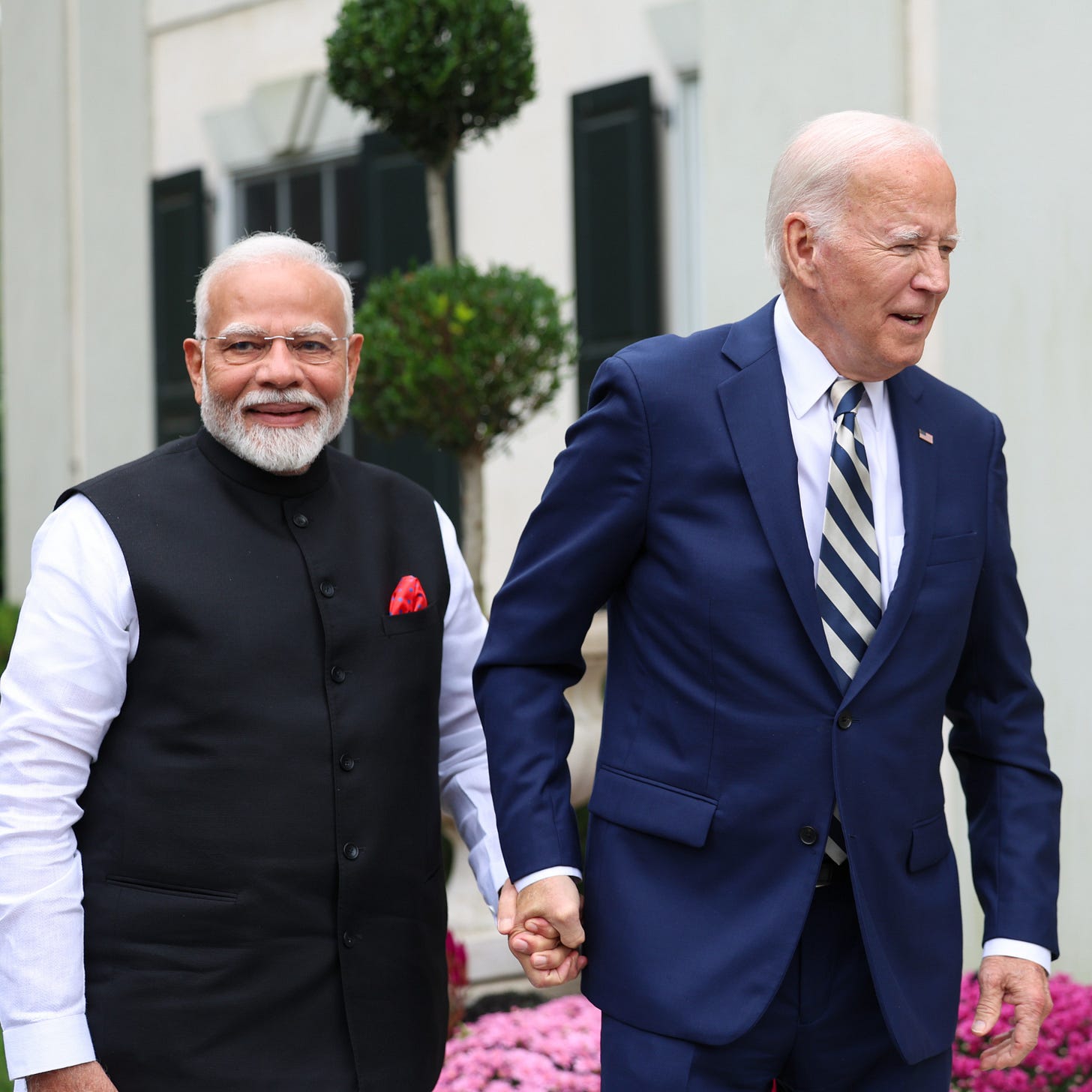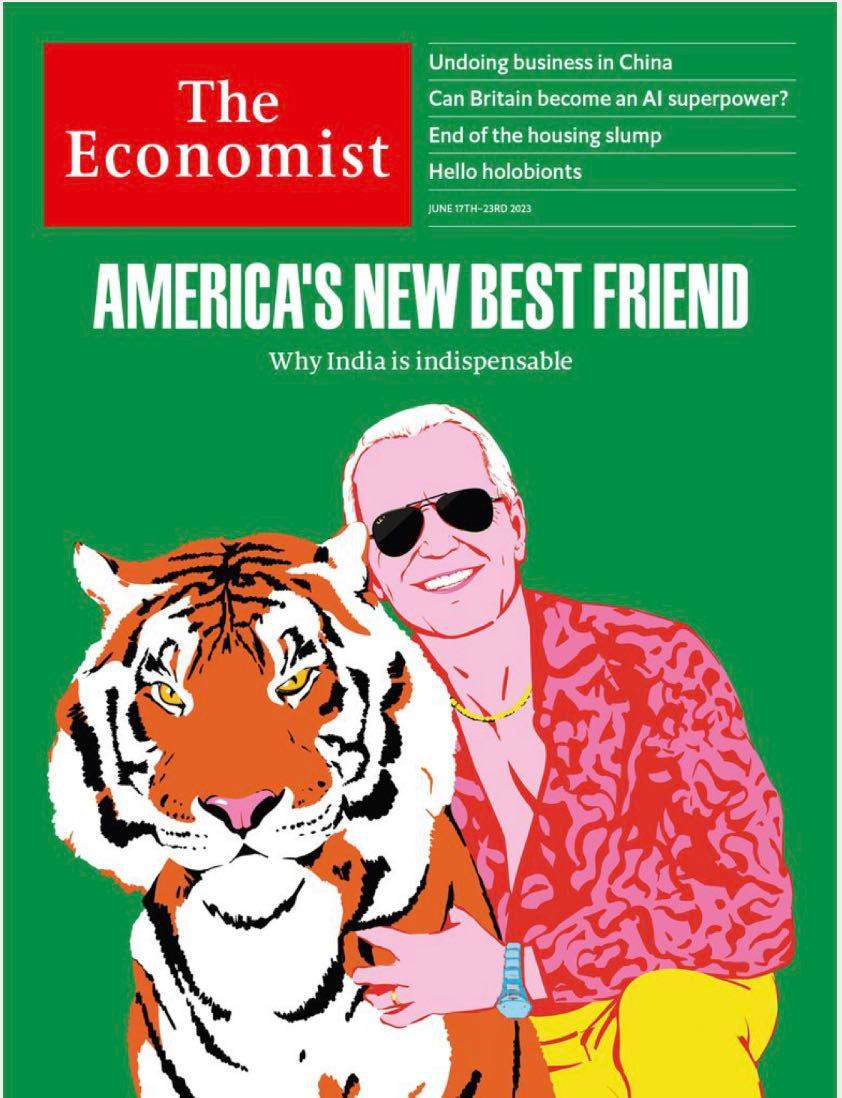India-US Relations Hit A Sweet Spot
Technology and business are emerging as the bedrock of the evolving relationship between the United States and India. EPISODE #196
Dear Reader,
A very happy Monday to you.
Last week, India and the United States renewed their commitment to grow the relationship between the two countries. Unlike the high voltage interaction last year between the leaders of the two countries, this time it was pure business, with both deciding to expand the scope and scale of the U.S.-India Comprehensive Global and Strategic Partnership.
Unprecedented emphasis on transfer of technology, especially the decision to create a semiconductor fabrication facility in India under the guidance of the US Department of Defence, and promoting business investments, with a focus on green energy, is emerging as the special glue that should help paper over occasional irritants in the bilateral relationship.
This week I unpack the import of the confabulations between Prime Minister Narendra Modi and US President Joe Biden.
The cover picture is sourced from Press Information Bureau.
Happy reading.
Biden’s Last Hurrah
In little over six weeks from now, the United States will elect its next President. Effectively, this makes the incumbent, Joe Biden, who opted not to stand again, a lame duck President—though he will continue to occupy the White House till the handover in January.
Despite this political handicap, President Biden combined with Prime Minister Narendra Modi to reiterate and celebrate the contours of the existing relationship between the two countries, deepening cooperation in technology—including creating the architecture to enable an unprecedented transfer of critical technology on design and manufacture of defence related semiconductors—and business-to-business or B2B cooperation.
In fact, the two leaders reiterated that the US-India Comprehensive Global and Strategic Partnership was “the defining partnership of the 21st Century”.
I would add, that like the inking of the US-India Civil Nuclear deal in 2005 was a turning point, the agreements clinched in the meeting last week, which also overlapped with an in-person meeting of the leaders of the QUAD nations, is a watershed. (QUAD is the Quadrilateral Security Dialogue, a strategic security conversation conducted between Australia, India, Japan, and the United States.)
To a large extent the two countries are taking advantage of the strong foundation that has been painstakingly created since Prime Minister Atal Bihari Vajpayee rewrote India’s foreign policy script and embraced a strategic relationship with the United States under the leadership of President George Bush.
No doubt, unbridled Chinese aggression in the neighbourhood, including a mindless border engagement with India that is now four years on, and an open challenge to US hegemony, hastened the process.
Nonetheless, the fact that this relationship has grown even during the tenure of political rivals in both countries—Republicans and Democrats in the US and the Bhartiya Janata Party (BJP) and Congress in India—is an unambiguous signal that it enjoys bipartisan support.
FAB News
The latest visit of PM Modi to the US—the eighth in the last 10 years—took up from where the prime minister had left off last year in his bilateral meeting with President Biden. Not only did it possess substance, it was very high on optics. It even prompted The Economist to do a cover story.
I had written a newsletter on this last year and hence will not repeat myself. Sharing the link below in case you wish to re-read it.
This time, the big takeaway was the decision to transfer technology in the design and production of semiconductors for use in critical sectors like defence and telecom. It is a big boost to India’s efforts to catch-up on deep tech innovations and create self-reliance in such critical technology.
The fact that this is being shepherded by the US Department of Defence, is an unprecedented first. Normally, the US is loath to transfer such critical technology, unless it is to an ally. This only reinforces the new degree of mutual comfort between the two countries, especially given the fact that India is not an ally of the United States.
Broadly, this will entail (Bold text is my doing):
Establishing a new semiconductor fabrication (FAB) plant focused on advanced sensing, communication, and power electronics for national security, next generation telecommunications, and green energy applications;
The FAB, will be established with the objective of manufacturing infrared, gallium nitride and silicon carbide semiconductors;
This will be spearheaded by the India Semiconductor Mission as well as a strategic technology partnership between Bharat Semi, 3rdiTech, and the US Space Force (part of the US Air Force);
Creating sustainable semiconductor supply chains including the setting up of GlobalFoundries’ (GF) Kolkata Power Center. (GF is an MNC, engaged in semiconductor contract manufacturing and design);
The GF centre in Kolkata will establish linkages in research and development in chip manufacturing and enable game-changing advances for zero and low emission as well as connected vehicles, internet of things devices, AI, and data centers.
In an interview to CNBC TV18, Vrinda Kapoor, CEO of 3rdiTech, a key player in the proposed technology transfer, said (bold text is my doing):
“We are talking about compound semiconductor fabrication, which is crucial to everything: national security, renewable energy and everything telecommunications. It doesn't work without any of these chips. It is a very different paradigm.
So it is basically is a very specialised skill set. The US government, the US Space Force in particular, will be providing the technology transfer to Bharat Semi, and 3rdiTech to design and manufacture these semiconductors.
In turn, India will be a resilient source of the semiconductors for the entire QUAD in a turbulent time where the shortage of semiconductors has massive national security implications.”
Effectively, the two countries are productionising the India-U.S. Initiative on Critical and Emerging Technologies (iCET) agreement inked last year between the US and India.
Co-led by the National Security Council Secretariat in India and the US National Security Council, iCET seeks to enable closer linkages between government, academia and industry of the two countries in areas such as Artificial Intelligence, quantum computing, 5G/6G, biotech, space and semiconductors to facilitate outcome-oriented cooperation.
Come to Africa
Another big takeaway from the summit meetings between the two countries last week is the convergence of their interests in Africa.
To create a green economy you need green minerals. And, in this there is no match for Africa as they are the global repository. Implicitly, like in the case of semiconductors, the intent is to break the strategic stranglehold China is asserting on access to green minerals.
Not only was China an early mover in targeting the primary sources of green minerals, its unbridled mercantilist philosophy provides strong ideological support in pursuing any means to an end.
I had written a newsletter last year, capturing how China was weaponising green minerals. Sharing the link below, in case you wish to re-read it.
The roadmap delineated last week by the two countries specifically states (The bold text is the doing of the White House):
“To elevate and expand bilateral technical, financial, and policy support to expand complementary US and Indian manufacturing capacity for clean energy technologies and components and lay the groundwork for enhanced cooperation in third countries, with a focus on partnerships in Africa”
Promising to unlock financial support, the joint statement proposed immediate investments in expanding manufacturing capacity for the following clean energy supply chain segments:
Solar wafers and wafer manufacturing equipment and next generation solar cells;
Wind turbine nacelle components;
Power transmission line components including conductors, cabling, transformers, and next generation technologies;
Energy storage components including batteries;
Battery packs for two and three-wheel electric vehicles (EVs) and zero-emission e-bus and truck components;
High-efficiency air conditioners and ceiling fan components.
The two governments agreed to collaborate with the private sector in both countries to roll out pilots and invest in clean energy in Africa.
Check out the comments sourced from the Roadmap For U.S.-India Initiative to Build Safe and Secure Global Clean Energy Supply Chains issued by the White House on 21 September. Again the bold text is the doing of the White House.
Collaborating with the private sector to scope eligible opportunities in the above supply chain segments and support an initial package of pilot projects, ideally including one project focused on clean energy deployment to Africa.
Building trilateral relationships with African partners that have stated political commitments to clean energy deployment, focusing on solar and battery storage opportunities. India and the United States can work multilaterally with African partners to pursue high-potential solar and EV deployment opportunities, understand the conditions required for project success, detail the partnerships and financial model for project success, and implement the project. The United States intends to collaborate with Indian companies to explore investment opportunities and facilitate public-private matchmaking expand partnerships with local African manufacturers.
To sum up then, the US and India are deepening their cooperation, including collaborating jointly in forging strategic ties in partner countries in Africa. Their relationship has come a long way in the last two-and-a-half decades. The events of last week suggest that the best is yet to come.
Recommended Viewing
Sharing the latest episode of Capital Calculus.
Little over a fortnight ago, Nature magazine published a research paper on India’s mission to provide toilets in every home—Swachh Bharat. The core finding of the research was that this had ended the practice of open defecation and in turn led to the saving of 60,000-70,000 lives of children every year.
A happy coincidence that this acknowledgment came just weeks before the 10th anniversary of the Swachh Bharat Mission.
To unpack these findings I spoke to Shamika Ravi, economist and member of the Prime Minister’s Economic Advisory Council (PMEAC). In an insightful conversation Shamika highlighted the obvious gains from Swachh Bharat and unintended benefits, including a behavioural makeover. Do watch.
Sharing the link below:
Till we meet again next week, stay safe.
Thank You!
Finally, a big shoutout to Kapil, Shyamsunder, Aashish and Gautam for your informed responses, kind appreciation and amplification of last week’s column. Once again, grateful for the conversation initiated by all readers. Gratitude to all those who responded on Twitter (X) and Linkedin.
Unfortunately, Twitter has disabled amplification of Substack links—perils of social media monopolies operating in a walled garden framework. I will be grateful therefore if you could spread the word. Nothing to beat the word of mouth.
Reader participation and amplification is key to growing this newsletter community. And, many thanks to readers who hit the like button😊.





